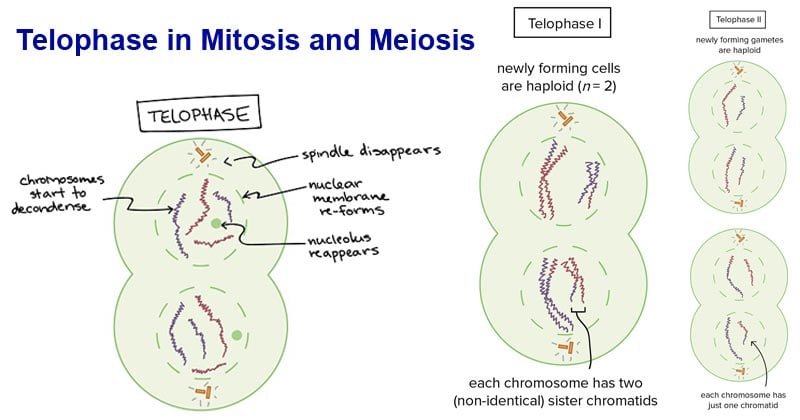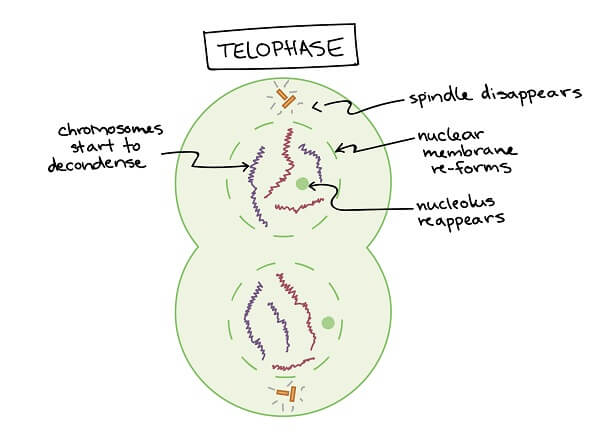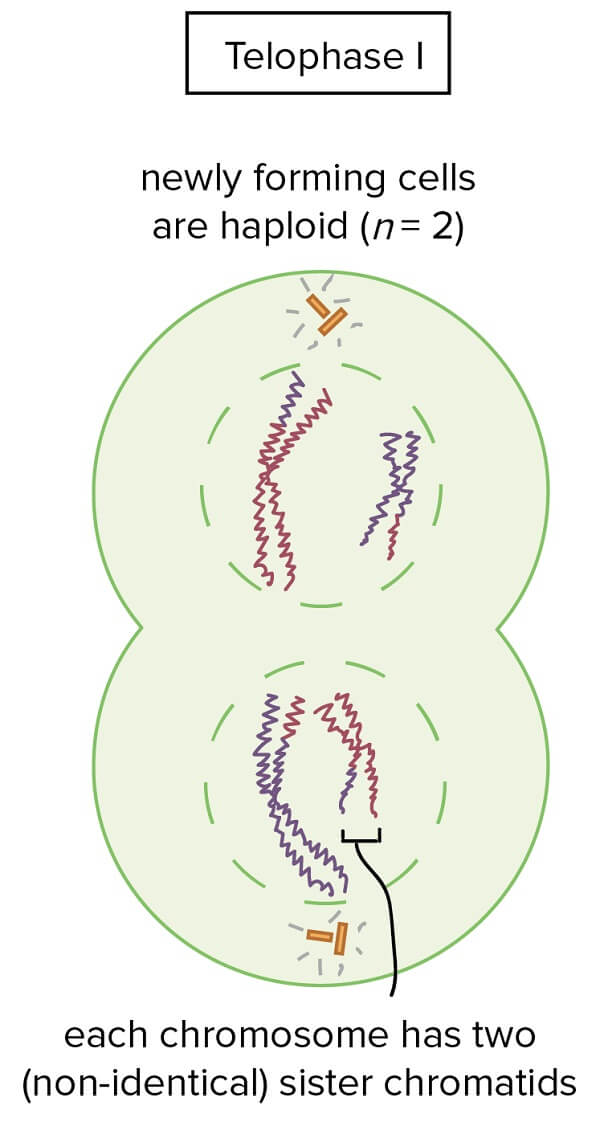Telophase is the fifth phase of mitosis and the final phase of meiosis as well.
In meiosis, there are two phases: telophase I and telophase II. This is the separation stage of duplicate genetic materials carried in the cell nucleus of the parent cells. They end up forming two identical daughter cells. Telophase starts after replication when the paired chromosomes are separated and pulled to the cell’s opposite poles.
Interesting Science Videos
What happens during Telophase?
During telophase, nuclear membrane forms around each set of chromosomes. This separates the nuclear DNA from the cytoplasm. The chromosomes then start to uncoil becoming diffuse and less compact. This phase is followed by cytokinesis which divides the cytoplasm of the parental cell to two daughter cells.

Figure: Telophase in Mitosis and Meiosis. Image Source: Khan Academy.
Telophase in Mitosis
Telophase in mitosis is significantly an extension of anaphase and metaphase that is controlled by the dephosphorylation of the mitotic cyclin-dependent kinase (CDK) substrate. There are various mechanisms that take place within this phase which leads to the formation of new daughter cells. These include:
Dephosphorylation of the mitotic Cyclin-Dependent Kinase substrate (Cdk)
- Phosphorylation of the mitotic Cyclin-dependent Kinase substrate leads to the spindle assembly, chromosome condensation, and nuclear envelope breakdown which takes place n the initial stages of mitosis.
- While dephosphorylation occurs as the mitotic cell cycle comes to an end in telophase. This allows for disassembling the spindles, mending the nuclear envelope, and chromosomal condensation of new daughter cells.
- One of the most significant Cdks is the Cdc-14 which is initially activated by being released into the nucleus from the nucleolus and exported to the cytoplasm.
- Its initial function is during the early stages of anaphase where it plays a key role in stabilizing the mitotic spindles and releasing more Cdc-14 into the nucleus where it becomes restricted.
- The restriction in the nucleus is later observed when it plays a major role in the Mitotic Exit Network (MEN) whereby it triggers spindle disassembly and the assembling of the nuclear envelope, during telophase.
- It also mediated dephosphorylation by activating downstream regulatory proteins specific for telophase such as CHD1 dephosphorylation proteins which target proteolysis leading to the cellular switching activity, eventually leading to the G1 phase of interphase.
- Dephosphorylation also leads to:
- Distancing of chromosomes from the metaphase plate triggering early telophase
- Cdc48 also triggers telophase mechanisms of spindle disassembly, nuclear envelope assembly, and chromosome condensation by activation ubiquitination in the proteasomes.
Mitotic spindle disassembly
- This is the shortening of the kinetochore microtubules, pulling the chromosomes to the poles of the cell and separating from the chromosomes.
Nuclear envelop reassembly
- This is the reconstruction of the double nuclear membrane, the formation of the nuclear pore complexes, and the formation of the internal nuclear lamina into the inner nuclear membrane.
- These organelles are dismantled during prophase and metaphase phases.
- The nuclear membrane is absorbed by the endoplasmic membrane during metaphase however targeting the nuclear membrane protein-containing vesicles of the endoplasmic reticulum to the chromatins takes place during telophase. This influences the formation of the nuclear envelope and the double-layered nuclear membrane.
Chromosome condensation
- Chromosome condensation (decompaction) forms expanded chromatin. The compact chromosomes are necessary for the cell’s preparation and initiation of the interphase.
- Condensation occurs parallel to the nuclear envelope assembly mediated by the Mitotic-Exit Network (MEN) Cyclin-Dependent Kinase dephosphorylation which restarts the interphase.

Figure: Telophase in mitosis. Image Source: Khan Academy.
Telophase in mitosis: Summary
- Telophase is the final phase of mitosis.
- The processes involved here are a reverse of what happened in anaphase and metaphase, whereby a new nuclear membrane is formed, the unfolding of the chromosomes into chromatins, the cell nucleoli reappears and the cell starts to enlarge, again.
- During this phase, the sister chromatids reach the opposite poles of the cell.
- The small nuclear vesicles in the cell start to reform around the chromosomes at the end of the cell.
- The nuclear envelope reforms by associating with the chromosomes, forming two nuclei in one of the new cells.
- This is the phase where the kinetochore microtubules are also dissolved while the polar microtubules continue to elongate.
- As the reformation of the nuclear envelope takes place, the chromosomes start to condense, becoming more diffuse.
Telophase in Meiosis
Telophase I
- During telophase I, the homologous chromosomes separate into separate nuclei.
- The cell reforms its nuclear envelope disassembles the spindle fibers microtubules and proceeds to cytokinesis.
- The cell then goes through a resting phase known as interkinesis.

Figure: Telophase I in meiosis. Image Source: Khan Academy.
Telophase II
- At this stage, the sister chromatids of each chromosome are already separate and during this phase, they get surrounded by a new nuclear membrane.
- However the cells originate from the same chromosome, differentiation is created during recombination whereby, part of the homologous chromosomes were exchanged in prophase 1.
- Four cells are formed by the end of meiosis with two alleles for each gene which are separated in several ways while combining with other alleles from other genes.

Figure: Telophase II in meiosis. Image Source: Khan Academy.
Video Animation: What happens in telophase? By MooMooMath and Science.
Reference and Source
- 1% – https://www.researchgate.net/publication/233538316_A_kinesin-mediated_mechanism_that_couples_centrosomes_to_nuclei
- 1% – https://www.ncbi.nlm.nih.gov/pmc/articles/PMC3501164/
- 1% – https://www.cell.com/cgi/content/full/117/3/361/DC1
- 1% – https://quizlet.com/118059230/the-cell-cycle-and-mitosis-flash-cards/
- 1% – https://owlcation.com/stem/Stages-of-the-Cell-Cycle-Mitosis-Part-2-of-2
- 1% – https://en.m.wikipedia.org/wiki/Telophase
- 1% – https://biologydictionary.net/telophase/
- 1% – https://biologydictionary.net/prophase/
- 1% – https://answers.yahoo.com/question/index?qid=20070515070459AATdqtH
- <1% – https://www.thoughtco.com/daughter-cells-defined-4024745
- <1% – https://www.sparknotes.com/biology/cellreproduction/mitosis/section3/
- <1% – https://www.sciencedirect.com/topics/biochemistry-genetics-and-molecular-biology/telophase
- <1% – https://www.researchgate.net/publication/6680673_Novel_Role_for_Cdc14_Sequestration_Cdc14_Dephosphorylates_Factors_That_Promote_DNA_Replication
- <1% – https://www.ncbi.nlm.nih.gov/pmc/articles/PMC2043359/
- <1% – https://www.answers.com/Q/What_separates_DNA_from_the_cytoplasm_in_eukaryotic_cells
- <1% – https://www.answers.com/Q/How_many_cells_have_formed_at_the_end_of_meiosis_2

